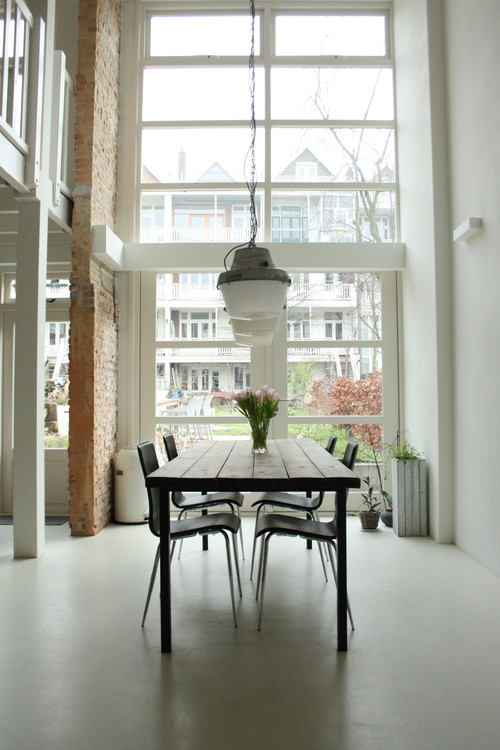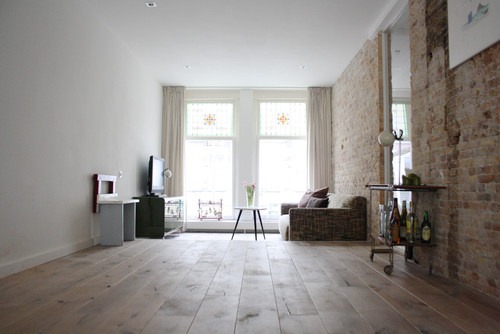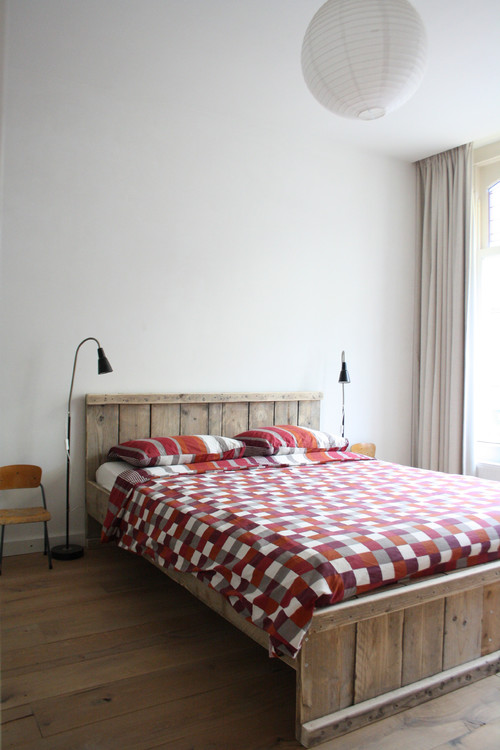Design Dilemma: Going Industrial, Softly
The hard-edged industrial look has become a favorite among designers and architects. Steel beams, stainless steel appliances, concrete floors and industrial fixtures have become trendy not only in city lofts but in suburban ranch houses.
Have you been intrigued by this look but afraid it might be a little too cold to live with on a day-to-day basis? We’ve found a wonderful example of “soft” industrial which manages to retain warmth and coziness while at the same time retaining the “edge” that makes the industrial look so appealing.
Welcome to the 19th-century, three-story home of Stella Verbrugge and Joeri van Zwoll in Rotterdam, The Netherlands. The couple was not intentionally seeking an industrial aesthetic, but one seemed to develop during the remodeling of their 2, 368-square-foot home.
Below is a view of their dining room. The industrial feel is enhanced with industrial-style vintage pendants from Spoor38. The wooden dining table continues that theme with handmade iron legs fashioned from planks of wood rescued from a factory. True to industrial style, the windows are kept bare. Some exposed brick is allowed to peak through on a supporting column.
The kitchen features concrete countertops and stainless steel appliances. The cabinets are from Ikea but the couple had the oak cupboard fronts custom made locally by Koak Design, which specializes in customizing Ikea kitchen cupboard fronts.
Here’s another view:
Below is a view of the living room. The couple opted to keep one exposed brick wall that runs the entire length of the home on all three stories.
The guest bedroom features a wood plank bedframe, and simple lighting.
And here, a stark white, utterly simple bathroom:
Why does this industrial-style, minimalist home seem so much softer than other versions of the industrial look we have seen? We attribute it to a few key points:
- This home does make use of color, albeit restrained. The soft pistachio color in the kitchen goes a long way to creating a warmer, softer feeling. Touches of color and pattern, as on the bedspread in the guest bedroom, also provide a soft feel.
- Warm wood is found in abundance. This home is not all glass and steel. Warm wood materials, such as the oak cabinets, wooden dining table and wood plank bed, add character and a quirky rustic quality that is a wonderful counterpoint to other more industrial elements. Oak flooring which runs through much of the house, also softens things up.
- Curtains help soften windows. Although the dining room does not incorporate a window treatment, many of the rooms of the rest of the home do. Curtains in the bedrooms, living room and family room provide a homespun feel.
- Architectural elements rely on brick and wood rather than steel. The large wooden beams and the exposed brick walls also provide a warm element. While they are raw, they’re not cold.
We think this home is a fabulous example of how a minimal, industrial aesthetic can still feel like a home. Sure, add the industrial light fixtures and expose some brick. Allow some elements to be raw and unfinished. However, you can still choose to paint walls colors, use curtains, and even throw down a rug or two. These days, the industrial look has moved beyond the factory!







Leave a Comment